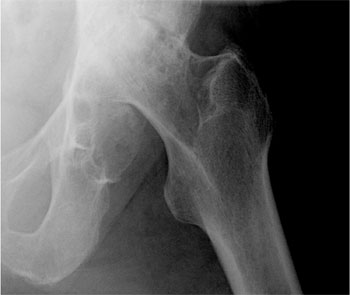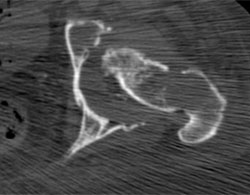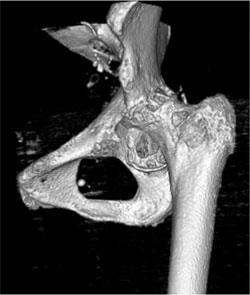Pigmented villonodular synovitis in a patient with prior history of breast cancer
An 89-year-old woman presented to our institution after a mechanical fall. She had a remote history of breast cancer with left breast mastectomy in 1978. She also had degenerative joint disease and underwent right hip replacement in 1994. She complained of progressive left hip pain for the past three months and has been using a walker at home. Examination revealed left hip erythema and tenderness with limited range of motion. The rest of the examination was otherwise unremarkable.
|
Photos courtesy: M Ghesani |
Radiography of the left hip revealed marked deformity of the left femoral head with sclerosis of the acetabular cup and femoral head; there was cortical disruption in the subcapital region of the femoral head with destruction of the trabulae suggestive of fracture with avascular necrosis. CT scan of the left lower extremity revealed pathological basicervical fracture of the left hip with abnormal soft tissue density in the marrow cavity; there was flattening of the left femoral head with degenerative subchondral cysts, loss of cartilage and subchondral bone. The patient underwent left hip replacement with no complications. Pathology revealed severe degenerative joint disease, hypertrophic synovium with pannus, hematopoietic marrow with benign lymphoid aggregates, histiocytic reaction and extensive fibrosis consistent with pigmented villonodular synovitis.
|
|
Discussion
Pigmented villonodular synovitis is an uncommon disease and remains a diagnostic challenge. It is a benign proliferation of the synovial lining, bursae and tendon sheaths. Annual incidence is estimated at 1.8 to two cases per million population with no genetic, environmental or occupational predilection. The exact etiology is still unknown, although several hypotheses are possible, including benign neoplasia, repeated nontraumatic inflammation, or response to blood products within the joints. The knee is most commonly affected, followed by the hips, shoulders, and small joints of the hands and ankles. It has an insidious presentation with monoarticular joint swelling, pain and joint locking. Pigmented villonodular synovitis is often misdiagnosed as osteoarthritis, rheumatoid arthritis, or other inflammatory or neoplastic processes.
|
|
Radiography can have very subtle changes with bony erosions in the head and neck of the femur and acetabulum in about 95% of patients. CT generally shows a hyperdense soft tissue mass in joints or tendon sheaths. MRI has a higher diagnostic value with features of joint effusion, hyperplastic synovium and low signal intensity signifying the hemosiderin deposits. The diagnosis is confirmed by biopsy of the synovium with characteristic fibrous stroma, hemosiderin deposition, histiocytic infiltrate and giant cells. Treatment of choice is synovectomy.
|
|
|
|
Irene Dy, MD, is a Fellow in Hematology and Oncology at St Luke’s-Roosevelt Hospital Center.
Gabriel Sara, MD, is in the Division of Hematology & Oncology at St Luke’s-Roosevelt Hospital Center and Assistant Clinical Professor of Medicine at the College of Physicians & Surgeons at Columbia University.
Carlos Benitez, MD, is a Musculoskeletal Radiologist at St. Luke’s Roosevelt Hospital Center and Assistant Professor of Clinical Radiology at Columbia University, College of Physicians and Surgeons.
Munir Ghesani, MD, is Associate Clinical Professor of Radiology at Columbia University College of Physicians and Surgeons and Attending Radiologist at St. Luke’s-Roosevelt Medical Center.





